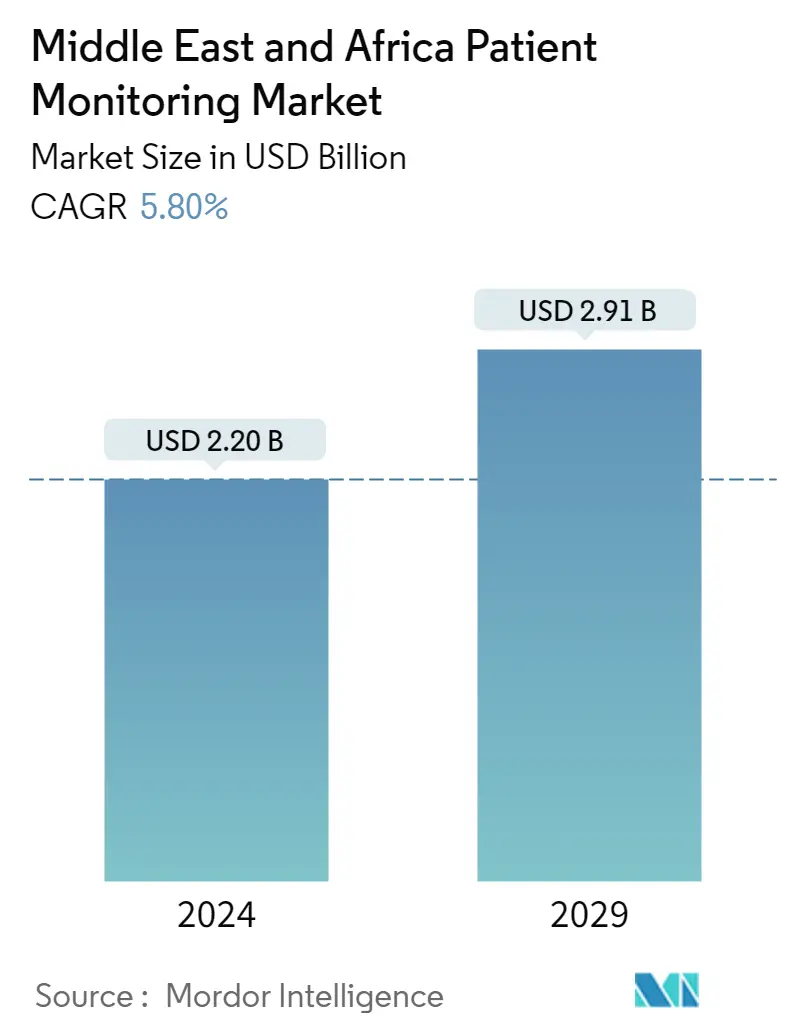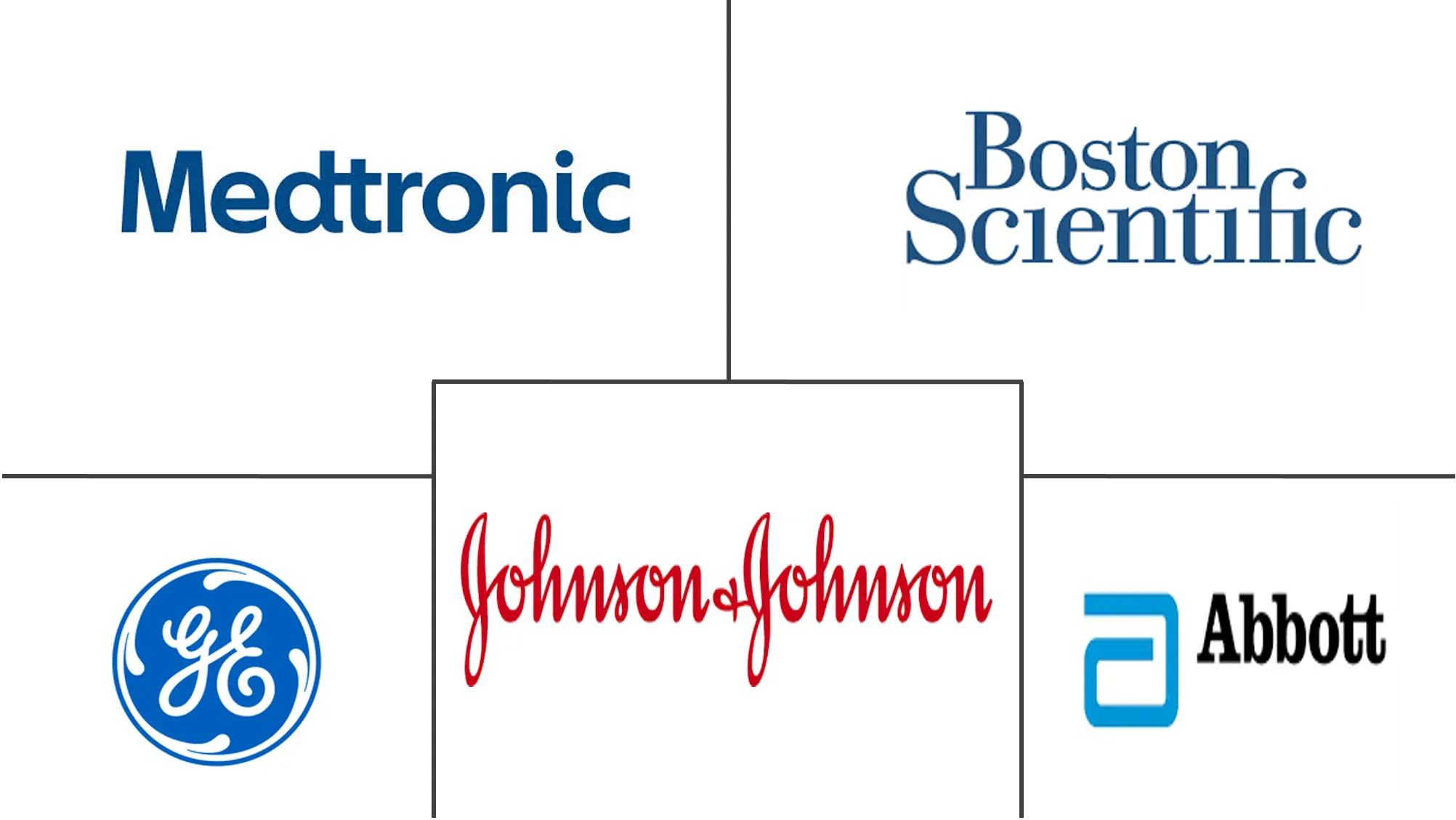Market Size of Middle East and Africa Patient Monitoring Industry

| Study Period | 2019 - 2029 |
| Base Year For Estimation | 2023 |
| Forecast Data Period | 2024 - 2029 |
| Market Size (2024) | USD 2.20 Billion |
| Market Size (2029) | USD 2.91 Billion |
| CAGR (2024 - 2029) | 5.80 % |
Major Players
*Disclaimer: Major Players sorted in no particular order |
Middle East and Africa Patient Monitoring Market Analysis
The Middle East and Africa Patient Monitoring Market size is estimated at USD 2.20 billion in 2024, and is expected to reach USD 2.91 billion by 2029, growing at a CAGR of 5.80% during the forecast period (2024-2029).
COVID-19 is expected to have a significant impact on the growth of the market. COVID-19 increased the demand for patient monitoring in the Middle East and Africa region owing to the restriction of patients' visits to the hospital. Government organizations provided various services to help monitor the condition of patients infected with COVID-19. For instance, in April 2020 the Saudi Ministry of Health launched an app aimed at monitoring the conditions of people suspected of having Coronavirus disease (COVID-19). Such government initiatives provided to monitor the condition of patients contributed to the growth of the market during the pandemic period. Also, during the post-pandemic period, the increasing adoption of patient monitoring in the Middle East and Africa region is expected to contribute to the growth of the market.
The key factors propelling the growth of the market are the rising burden of chronic diseases due to lifestyle changes, growth in the geriatric population, growing preference for home and remote monitoring, and ease of use and portability devices to promote growth. According to GLOBOCAN 2020, it was estimated that around 27,885 new cancer cases were reported in Saudi Arabia in 2020. Similarly, it was estimated that around 4,807 new cancer cases in the United Arab Emirates (UAE) and 3,842 new cancer cases were reported in Kuwait in 2020, respectively. With the high burden of cancer in the country, demand for effective treatment procedures also increases. This is ultimately helping in driving the biologics market growth in the GCC region. Also, according to the United Nations Population Fund's World Population Dashboard's Statistics 2021, in Kuwait, approximately 3.4% of the population of the country is aged 65 years and above. In addition, as per the World Population Ageing 2020 Report, in the United Arab Emirates, the population aged 60 years or above (thousands) in 2019 was 113 and the number is estimated to reach 1,679 by the year 2050. As the geriatric population is prone to suffer from various chronic diseases such as cardiovascular diseases, hypertension, diabetes, and others, are anticipated increase in population is expected to fuel the demand for the patient monitoring market.
Patient monitoring technologies identify small changes in the patient's physiological data, hence promoting self-monitoring. Thus, it reduces readmissions and prevents avoidable hospitalizations, decreases the number of unnecessary trips to the doctor's office, and reduces travel-related expenses. On a short- and long-term basis, by the proper implementation, patient monitoring technologies can expand access to quality healthcare and save time and money.
Thus the above-mentioned factors are expected to drive the demand for the growth of the market during the forecast period.
Middle East and Africa Patient Monitoring Industry Segmentation
As per the scope of this report, patient monitoring devices are monitoring devices that continuously monitor the patient's vital parameters, like blood pressure and heart rates, by using a medical monitor and collecting medical (and other) data from individuals. The Middle East and Africa Patient Monitoring Market is Segmented by Type of Device (Hemodynamic Monitoring Devices, Neuromonitoring Devices, Cardiac Monitoring Devices, Multi-parameter Monitors, Respiratory Monitoring Devices, and Other Types of Devices), Application (Cardiology, Neurology, Respiratory, Fetal and Neonatal, Weight Management and Fitness Monitoring, and Other Devices), End User (Home Care Settings, Hospital and Clinics, and Other End Users), and Geography (North America, Europe, Asia-Pacific, Middle East and Africa, and South America). The report offers the value (in USD million) for the above-mentioned segments.
| By Type of Device | |
| Hemodynamic Monitoring Devices | |
| Neuromonitoring Devices | |
| Cardiac Monitoring Devices | |
| Multi-parameter Monitors | |
| Other Types of Devices |
| By Application | |
| Cardiology | |
| Neurology | |
| Respiratory | |
| Fetal and Neonatal | |
| Others |
| By End User | |
| Home Healthcare | |
| Hospitals and Clinics | |
| Other End Users |
| Geography | |
| GCC | |
| South Africa | |
| Rest of Middle East and Africa |
Middle East and Africa Patient Monitoring Market Size Summary
The Middle East and Africa Patient Monitoring Market is poised for significant growth, driven by the increasing prevalence of chronic diseases and a rising geriatric population. The market's expansion is further supported by the growing preference for home and remote monitoring solutions, which offer ease of use and portability. The COVID-19 pandemic has notably accelerated the demand for patient monitoring technologies, as restrictions on hospital visits prompted governments to implement innovative monitoring solutions. These developments have not only contributed to the market's growth during the pandemic but are also expected to sustain momentum in the post-pandemic period. The market is characterized by the adoption of advanced monitoring technologies that facilitate early detection of health issues, thereby reducing hospital readmissions and enhancing healthcare accessibility.
Key players in the Middle East and Africa Patient Monitoring Market include Abbott Laboratories, Boston Scientific Corporation, Becton, Dickinson and Company, General Electric Company (GE Healthcare), Johnson & Johnson, and Medtronic Care Management Services LLC. These companies hold substantial market shares and are actively involved in strategic collaborations and technological advancements to strengthen their market positions. For instance, collaborations like that of BioIntelliSense Inc with Mubadala Health aim to integrate innovative remote care technologies, enhancing clinical workflow efficiencies. Additionally, the launch of telemedicine apps, such as Cardo Health's Kena Health in South Africa, targets underserved populations, further driving market growth. South Africa is expected to dominate the market due to its high diabetes prevalence and significant geriatric population, which necessitate robust patient monitoring solutions.
Middle East and Africa Patient Monitoring Market Size - Table of Contents
-
1. MARKET DYNAMICS
-
1.1 Market Overview
-
1.2 Market Drivers
-
1.2.1 Rising Burden of Chronic Diseases due to Lifestyle Changes
-
1.2.2 Growing Preference for Home and Remote Monitoring
-
-
1.3 Market Restraints
-
1.3.1 Resistance from Healthcare Industry Professionals Toward the Adoption of Patient Monitoring Systems
-
1.3.2 High Cost of Technology
-
-
1.4 Porter's Five Force Analysis
-
1.4.1 Threat of New Entrants
-
1.4.2 Bargaining Power of Buyers/Consumers
-
1.4.3 Bargaining Power of Suppliers
-
1.4.4 Threat of Substitute Products
-
1.4.5 Intensity of Competitive Rivalry
-
-
-
2. MARKET SEGMENTATION (Market Size by Value - USD million)
-
2.1 By Type of Device
-
2.1.1 Hemodynamic Monitoring Devices
-
2.1.2 Neuromonitoring Devices
-
2.1.3 Cardiac Monitoring Devices
-
2.1.4 Multi-parameter Monitors
-
2.1.5 Other Types of Devices
-
-
2.2 By Application
-
2.2.1 Cardiology
-
2.2.2 Neurology
-
2.2.3 Respiratory
-
2.2.4 Fetal and Neonatal
-
2.2.5 Others
-
-
2.3 By End User
-
2.3.1 Home Healthcare
-
2.3.2 Hospitals and Clinics
-
2.3.3 Other End Users
-
-
2.4 Geography
-
2.4.1 GCC
-
2.4.2 South Africa
-
2.4.3 Rest of Middle East and Africa
-
-
Middle East and Africa Patient Monitoring Market Size FAQs
How big is the Middle East and Africa Patient Monitoring Market?
The Middle East and Africa Patient Monitoring Market size is expected to reach USD 2.20 billion in 2024 and grow at a CAGR of 5.80% to reach USD 2.91 billion by 2029.
What is the current Middle East and Africa Patient Monitoring Market size?
In 2024, the Middle East and Africa Patient Monitoring Market size is expected to reach USD 2.20 billion.

